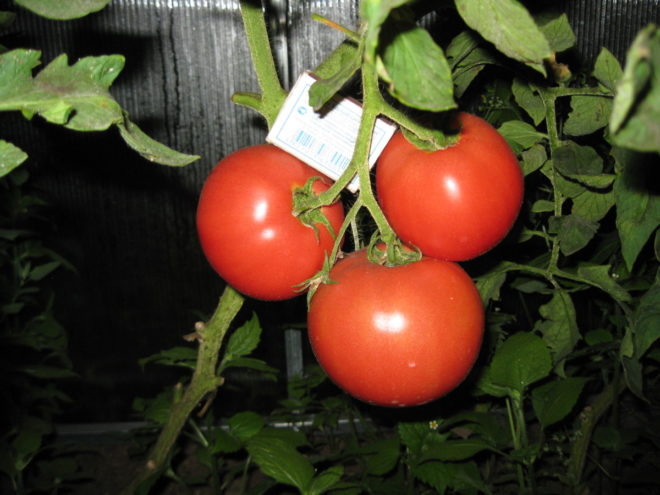 What could be tastier than boiled potatoes with pickled tomatoes and crispy pickles? But to get good pickles and pickles, you will have to take care of the right choice of tomato varieties for winter harvesting.
What could be tastier than boiled potatoes with pickled tomatoes and crispy pickles? But to get good pickles and pickles, you will have to take care of the right choice of tomato varieties for winter harvesting.
A variety of Homemade pickles, produced by the well-known company Siberian Garden, is perfect for this.
Content
One of the best for canning
Already from the name it is clear that this variety of tomatoes was created specifically for lovers of pickles, pickles, preserves. Not every tomato is “ready” for such tests, since it is required that the fruits have a dense skin, pulp, small size (it is more convenient to put tomatoes in jars), do not lose their taste during processing.
Mid-early Home-made pickles are from such varieties. A small bush during the fruiting period is hung with oblong bright red tomatoes. This variety belongs to the group of determinant tomatoes, the plant is low, very compact. In open ground, the height of the bush reaches only 40-50 cm.
The plant is medium-sized, the stem is dense, stocky. The fruits ripen quite amicably, from germination to the appearance of the first tomatoes, about 100 days pass.
In shape, Homemade pickles are slightly oblong, resembling round cylinders. The peel and pulp are dense, the color is bright red. The skin is even, smooth, with a little gloss.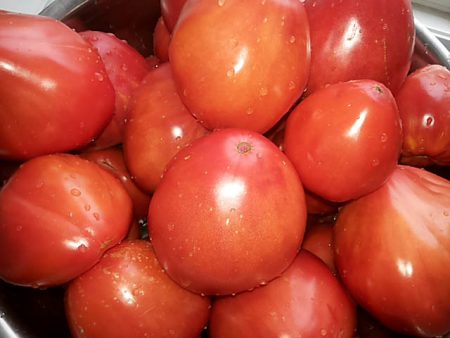
Tomatoes are aligned in size, on average, the weight of each fruit is about 100 grams. On the first brush there may be specimens slightly larger - up to 130-150 grams.
Due to the dense pulp, a sufficiently high sugar content, this variety is ideal for preparing all kinds of blanks. Home-made pickles are tasty in pickles, assorted (with cucumbers, squash), in pickles and in preservation.
The taste of fresh fruits is pleasant, but judging by the reviews of gardeners, it improves in pickling and preservation. Bright and even tomatoes look beautiful in jars, and by the gustatory quality no purchased delicacies can be compared with homemade pickles. By the way, salted and canned tomatoes are an excellent way to increase appetite. They are considered low-calorie foods, and, in salted tomatoes, more nutrients are stored than in pickled vegetables.
The fruits of Homemade pickles are suitable for transportation, well stored. The variety is resistant to disease, tolerates temperature extremes, it is recommended for cultivation in areas of risky farming.
Advantages and disadvantages of the variety Homemade pickles
Breeders of the Siberian Garden company offer gardeners seeds of tomatoes, which are intended for growing in difficult climatic regions.
The variety Homemade pickles will please you with a very good yield for a compact bush (up to 6 kg per square meter), unpretentiousness.
The advantages also include:
- early fruit ripening (this is especially important in the conditions of a short summer);
- resistance to adverse weather conditions;
- good taste of tomatoes;
- flatness of the fruit;
- excellent commodity characteristics of tomatoes;
- the possibility of use in conservation (the variety is designed specifically for the preparation of various blanks);
- good keeping quality of fruits;
- suitability for transportation.
Homemade pickles seeds can be obtained from tomato fruits themselves. Among the shortcomings, we note the need for plant pinching, since this technique allows you to increase productivity.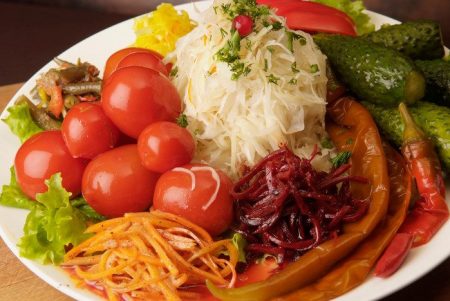
Agriculture of tomato varieties Homemade pickles
The variety is recommended for cultivation in open ground, a seedling method is used. Ready seedlings are planted on ridges at the age of 60 days.
Preparing seeds for sowing
Tomato seeds need pre-sowing treatment. Such procedures can improve the germination of crops, increase the immunity of plants to diseases, pests, and, consequently, increase productivity.
Seed Preparation Activities:
- disinfection (potassium permanganate is used, soaking in an aqueous solution for no more than 20 minutes);
- soaking in a growth stimulant or water extract of wood ash;
- germination in wet tissue.
Some gardeners additionally sparging tomato seeds, hardening them at a temperature of minus 1ºC. Each one decides for himself whether to completely carry out the whole complex of procedures or to limit himself only to disinfection, stimulation of seeds and germination.
Soil is prepared in advance before sowing, as well as containers for future seedlings. Drawers and containers, pots of peat, cups will do. Typically, tomatoes are first sown in common containers, and then picked.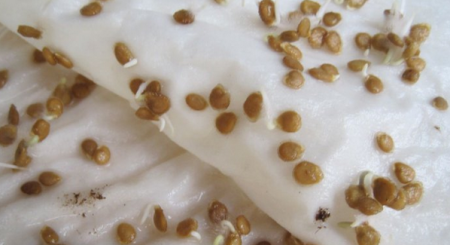
As a seedling mixture suitable soil purchased or you can make such a mixture yourself. Structure:
- sheet land (can be replaced with turf);
- peat;
- calcined river sand.
Proportions: 2: 2: 1. As a fertilizer, after calcination add ash (a couple of tablespoons), as well as superphosphate (a teaspoon per bucket).
Tomatoes of this variety are sown usually in March, counting the days according to the lunar calendar and the time of planting seedlings in open ground. In most regions, this is the end of May or even the beginning of June. When calculating, do not forget to take into account the time of seed germination (about 5-6 days).
Seeding and seedling care
Sow the seeds in the grooves, lightly sprinkle with earth and cover with glass from above. Boxes are cleaned in a warm place, the temperature should be in the range + 25ºC ... + 26ºC.
When the very first sprouts appear, the containers are exposed, the glass is removed. The temperature should be reduced to about + 18ºC and in this mode, keep the seedlings for about 5-6 days. Lowering the temperature is an important technique, eliminating the stretching of seedlings.
After that, the temperature is raised to + 23ºC ... + 25ºC - comfortable for tomatoes - in the afternoon, + 18ºC ... + 20ºC.
In the initial period, it is advisable to equip additional lighting for seedlings, water carefully, without eroding the soil and without exposing the roots. When tomatoes have 2-3 real carved leaves, you will need to pick. After this, the plants are shaded for two days from the sun, then grown in the usual way.
Before planting in open ground, tomatoes are fed twice (you can use complex fertilizer), watered as the soil dries.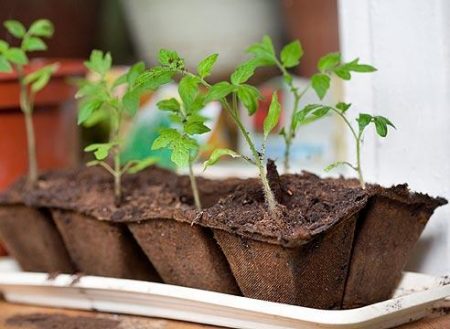
Landing
Tomato transplantation on the ridge should be preceded by mandatory hardening of seedlings. This is done so that the plants quickly adapt to a new place, avoid stress.
About 10-14 days before transplanting, tomatoes begin to accustom to new conditions. First they are taken out onto a loggia or veranda for about 15 minutes. Windows, windows should be open.Gradually, the time spent in the fresh air is increased, leaving the plants for several hours.
It is recommended to plant tomatoes on ridges only when the danger of frost return is over.
Hardened seedlings of the variety Homemade pickle take root quickly, tolerate slight drops in temperature without harming themselves. But still it is recommended to cover tomatoes on the beds for the first time with non-woven material.
Ridges should be prepared in the fall, in the spring - easy digging, fertilizing. Tomato is planted in holes, not more than 4-5 plants per square meter.
For about 10 days, it is recommended not to water the tomatoes (weather-oriented), so that the root system of plants grows. Many gardeners immediately after planting mulch the soil around the plants with straw, hay. This avoids the appearance of weeds, protects the soil from excess moisture and drought.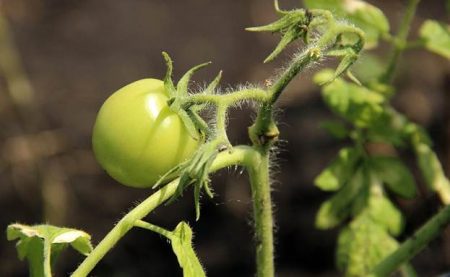
Outdoor tomato care
In the future, agricultural technology is reduced to standard techniques:
- watering (on a bed of tomatoes, moisture is often enough from rainfall);
- loosening (if the soil is not mulched);
- top dressing;
- bush formation.
Tomatoes love plentiful, but rare watering. On ridges, the problem of irrigation is often solved by rains, but in this case it is necessary to control the condition of the soil. Tomatoes do not like stagnation of moisture, they start to hurt, so it is best to mulch the soil around them.
Experts recommend staging the bush until the first flower brush. More than some special formation of the variety Homemade pickle is not required.
When feeding, they are guided by the timing of tomato vegetation. This variety is medium early, the crop ripens quickly. In the initial period, organic fertilizing is done (not earlier than 18-21 days after planting in the ground), for which you can use mullein. He is bred 1:10.
During budding, it is recommended to feed the tomatoes with phosphorus fertilizer (you can give foliar top dressing with superphosphate), then after a week and a half you can water the plants with ash infusion.
The first fruits of Homemade pickles reach a state of technical maturity about 100 days after emergence. They can be removed so that the plant can "engage" in the formation of the next batch of fruits. Typically, the ovary of tomatoes grows about 25-30 days (to the state of technical ripeness), then they still need about 18-20 days to ripen.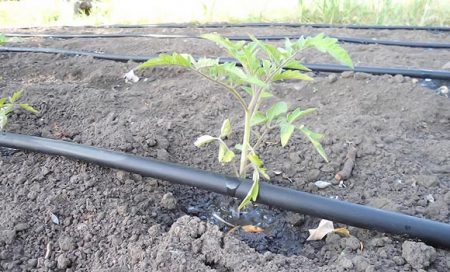
The state of biological ripeness is the achievement of a characteristic varietal color by a tomato. In this case, Homemade pickle turns bright red. Wait for complete redness is not worth it. Harvesting fruits in green will increase productivity, and the dense fruits of Homemade pickles ripen perfectly indoors.
Techniques to improve fruiting and accelerate ripening:
- reduction during the fruiting period of tomato dressing;
- spraying plants with iodine solution;
- processing bushes with a solution of sodium humate (during flowering).
The variety Homemade pickles is distinguished by a friendly return to the crop and, subject to simple techniques, will surely delight you with delicious fruits.
Reviews
Tatyana, Voronezh
I specially grow different tomatoes for salting: There was a honey drop, Cream, different cherry tomatoes. In a good sense, the variety Homemade pickle was surprised. I bought it because of the name, it turned out to be very successful. Fresh taste - like grass, in pickling (I prefer to salt in a cold way) - just delicious!
Next year I will try it in the marinade, I think it will not be worse.
Milan, Chelyabinsk
Last year, tomatoes were pleased, and new varieties too. In July it was cool for almost a week, but nothing, my tomato bushes all withstood and such a crop was good. I note Sevryuga and Homemade pickles, the last in seaming - is amazing.
It is very convenient that his tomatoes are oval, but not cream, namely round ones.The jars are well into the neck, the skin is elastic, the flesh is delicious. Opened when the banks in the winter, these left before other tomatoes.
Lyudmila, Altai
Of the new varieties of tomatoes last year I tried the varieties of Petrushu-gardener (I was going to plant for a long time), Homemade pickle and Ruby cup. I liked everything, but the pickle is best of all, perhaps. Parsley came out later, but for seizures just in time. The pickle is very fruitful, although the bush itself is a crumb. I grew them all in the open ground, the ridge was warm (the grass was buried since autumn yet). She fed only ash and all.
The fruits are very dense, I thought they would be just as solid in the marinade. But no, there the peel remained dense, but burst when eating. Tasty and so nice looking tomato. I will grow further.




 Low-growing tomatoes, without pinching: 5 of the most delicious varieties
Low-growing tomatoes, without pinching: 5 of the most delicious varieties Why tomato seedlings grow poorly
Why tomato seedlings grow poorly We grow a tomato in a shell
We grow a tomato in a shell Growing tomatoes without watering according to the method of Kazarin
Growing tomatoes without watering according to the method of Kazarin
Diets.Guru
Gorgeous and superior white-white varieties in nutritional value and richness of composition Savoy cabbage in Europe is more popular than in Russia. Experts are sure that adapted to local growing conditions varieties can change the situation, because softer and more flexible leaves are optimal for traditional cooking - it is easy to cook cabbage rolls, cabbage soup and other dishes from them. More important in this respect are the properties of Savoy cabbage, which, in addition to providing the body with minerals and vitamins, can prevent and slow down the growth of cancer cells. Such adapted varieties include the late-ripening and hardy variety Nadia.